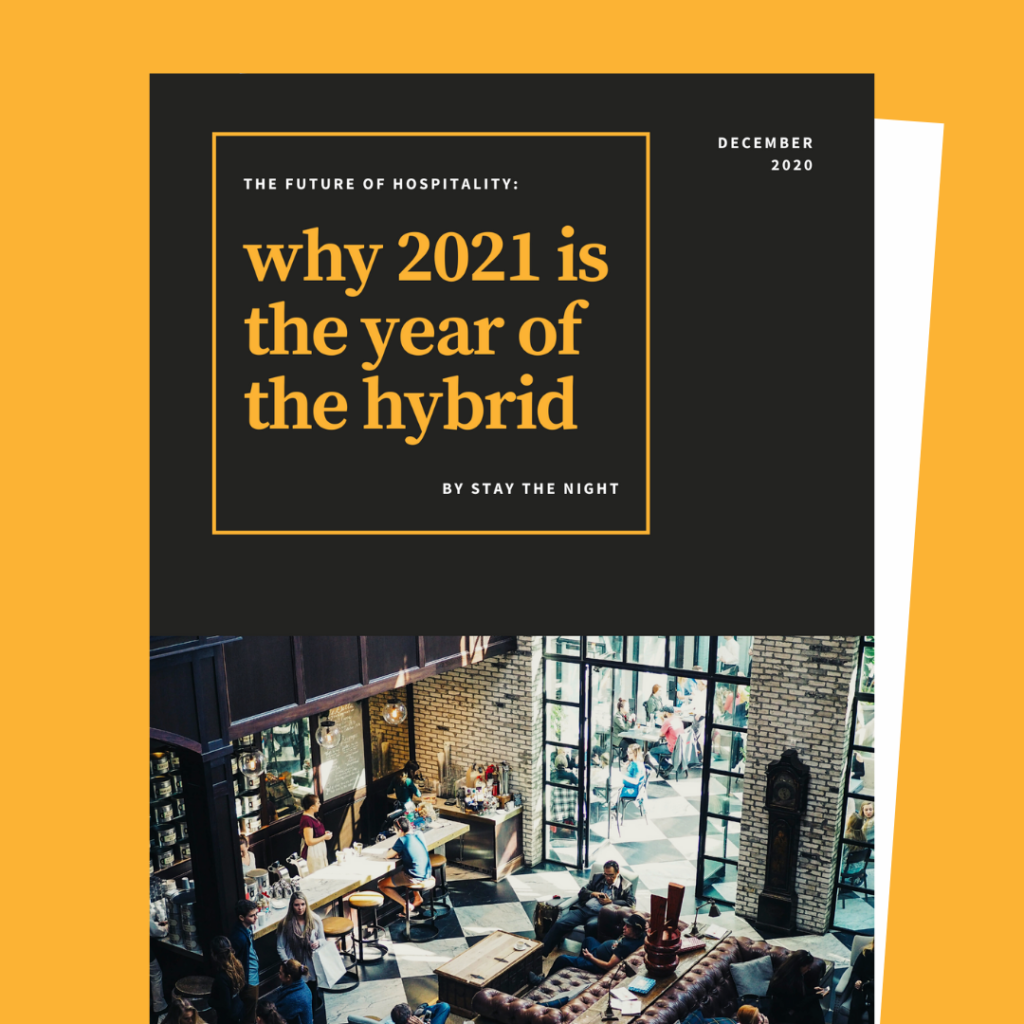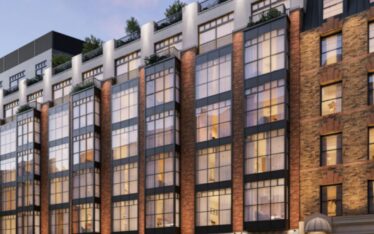The Covid-19 pandemic accelerated the already rapidly growing movement towards remote working – and as a result, we have seen a rise in the number of people working away from their homes, or on the move and seeking flexible workspace options.
In fact, a report from Airbnb showed a 128% increase in searches using the terms “relocation” and “remote work” from July to September 2020, compared to the same period in the previous year.
This movement has provided a huge opportunity for hybrid hotels and hostels. However, digital nomads and remote workers are not your typical guests – they have completely different requirements. As such, you will need to adapt your marketing to reach them and to convince them to book with you.
Here are our tips how to market your hotel to digital nomads and remote workers…
KNOW WHO YOU ARE TALKING TO
Before you jump in and start marketing, it’s important to have a clear picture of who you are talking to so that you are able to strategise accordingly. The goal is to make your target audience – in this case, digital nomads and remote workers – feel like you are speaking directly to them through your marketing.
Prior to strategising, it’s important to clearly define these two groups. While they share many similarities – including seeking community and adopting a flexible lifestyle – there is a difference that is important to acknowledge.
Remote workers are more likely to be local to your location but seeking a place to work outside of the home, whereas digital nomads are those hwo live and work while travelling. People can – and will – interchange between the two lifestyles.
To strategise effectively and truly understand who you are speaking to via your marketing, there are three initial steps you can follow. Firstly, whether these two segments have already been part of your target audience or you are thinking about tapping into these markets for the first time, you need to be utilising the data you have at your fingertips. To get an insight into your current audience, review your Google Analytics and social media data to determine key demographics – like age, location and gender – before looking at what content has driven traffic and bookings in the past so you can understand what resonates with them.
We also recommend analysing the reviews you receive. Looking at both positive and negative feedback gives you further insight into what motivates guests to book with you and, just as importantly, what might prevent them from booking. This is hugely valuable information to have to hand as you plan how you will communicate with your target audience about your brand.
Once you have the basic demographics, it’s time to dig a little deeper. Take the time to ask yourself – and research – what the values and booking motivations are for this target market. As well as fast, reliable Wi-Fi and a great space to work, remote workers and digital nomads value experiences and want to be part of a community where they can build relationships with like-minded people. If they are in a new place, then they will want to get to know the destination on a deeper level during their down time.
If you already have a community of digital nomads or remote workers who use your space, we recommend reaching out to them directly to find out their needs, the reasons why they use your spaces, and their thoughts on the experiences your brand offers. If you don’t yet have that, don’t worry – visiting sites such as www.nomadlist.com is a great way of finding out what digital nomads, in particular, are looking for. In the forums section of the site, you can find real-time conversations happening between digital nomads. Pay attention to the topics and issues they are discussing, and use this to inform your copy and content strategy. You can even filter the forums by country to make them specific to your location.
It’s also important to spend time building detailed guest personas – which are fictional profiles of your guests based on the information you have discovered from your data and research. Guest personas are a really useful tool to ‘get in the head’ of your target audience. They should not be a tool tucked away in your marketing strategy – instead, they should be regularly referred to until your team can think of them without looking.
Having guest personas at the forefront of your mind when it comes to marketing will ensure your content and communications really speaks to the people you are trying to reach. We recommend creating at least one guest persona per guest segment. With remote workers and digital nomads, you can break this down even further.
The likelihood is that you will have multiple target audiences – from employees working remotely for established 9-5 companies to freelancers, side hustlers and business owners – and gaining a deep understanding of their needs is pivotal to your success.
CREATE TARGETED CONTENT
Once you have a deeper understanding of the values and motivations of both digital nomads and remote workers, you should then create high-quality content which resonates with them by tapping into these needs. Remember, they are seeking more than just a nice-looking workspace and free WiFi – it’s important to showcase what you can offer and keep it at the forefront of your marketing.
There are a variety of ways to produce creative content which differentiates your brand from competitors and resonates with your target markets, including:
- SHARING SOCIAL PROOF – People want to hear about the experiences that those just like themselves are having in your spaces so it’s important to utilise the great reviews you receive via your own marketing channels. It’s actually far more trusted, too – 85% of consumers state that they find user-generated content influences their purchasing decisions more than brand content.
- CREATING A DAY IN THE LIFE OF… SERIES: Leading on from utilising past reviews, it’s important to showcase what your customer base are getting up to. Whether it is a nomadic guest sharing the lifestyle they lead during their time staying with you or a remote worker vlogging their daily routine, creating a ‘day in the life’ series on your blog or via video content will give your potential guests a deeper insight into the community you have created.
- RUNNING A REGULAR Q&A SERIES – Often, it can be useful to go directly to the source and give your potential guests the opportunity to ask you questions. You could set a theme for the type of questions you will answer or allow general queries – we recommend using InstaStories as a platform for this. This offers a chance for your brand to authentically engage with your audience and allows them to clear up any queries they may have that could be preventing them from booking a stay or using your space.
- PUBLISHING PRACTICAL GUIDES – While remote workers and digital nomads are similar in a lot of ways, they will look for different kinds of practical information when researching a place to work from. To reach these types of guests during their research phases, create guides – via your blog or Instagram’s new ‘Guides’ feature – with practical information that will be genuinely valuable to them. For example, you could create content targeting digital nomads around how to efficiently and affordably travel around your destination.
Remember, it’s important to switch up the content you create between video, blog and photo to maximise discoverability online among your target markets.
USE TAILORED LANDING PAGES
As well as creating targeted content for digital nomads and remote workers, you can go one step further with tailored landing pages.
Landing pages are standalone web pages created for specific campaigns – it’s where a user will “land” when they click a link. They allow you to target specific guest segments and offer them something of real value.
While creating landing pages creates more work up front for you and your marketing team, it is a powerful tool in terms of boosting your ROI – particularly when combined with paid social advertising – so it is absolutely worth it.
As an example, when we introduced tailored landing pages to one of our client’s paid ad campaigns, we increased conversions by 43% and boosted the return on their investment to 18:1 – which meant for every £1 they put into their ads budget, they got £18 back in increased revenue.
In terms of getting it right, simplicity is key. You don’t want to clutter your landing page with lots of information that will distract your potential guests from the action you want them to take.
Our top tip when it comes to creating effective landing pages is to follow the rule of one – so for each page, you should have:
- ONE TARGET AUDIENCE – in this case, digital nomads or remote workers
- ONE KEY MESSAGE – which could be sharing an extended stay discount or coworking space offer
- ONE CALL TO ACTION – this can be in the form of a ‘book now’ or ‘enquire now’ button
Once your landing pages are up and running, be sure to track their success via your analytic insights. We also recommend split testing with different content to see what works for your audience when it comes to increasing conversions.
HARNESS THE POWER OF PACKAGES
Earlier in the year, we wrote an ebook – The Staycation Marketing Guide – which included information on the power of packages for your brand.
Creating packages for your brand provides a variety of benefits to your business. These include:
- INCREASED REVENUE – An Expedia report found that hotel guests who purchase packages spend more on their rooms – and book more room nights – compared to those who opt for standalone rooms. They also found those who opt for a package paid around 30% more in average daily room rates (ADRs) therefore by offering special deals and promotions, you are able to increase both the perceived value of their guest experience and the financial yield from their bookings.
- INCREASED DIRECT BOOKINGS – Your package differentiates your brand from OTAs and give guests a real motivation to book directly with you for a great deal that they can’t find elsewhere.
- LONGER STAY WINDOWS – Here in the UK, package bookings have typically almost double the length of stay than a standalone accommodation booking. Packages can also tend to have a longer booking window which means you will have more opportunities to up-sell to your guests prior to check-in via effective email marketing.
From the perspective of a digital nomad visiting a new location, purchasing a package takes the stress out of planning and managing multiple aspects of their trip separately. It also allows them to keep track of their budgeting easily and saves time.
However, to receive significant uptake in the packages you build, you need to go beyond the typical ‘get 15% off when you book directly’ – your guests are savvier than ever and have become increasingly wary of offers like this. We recommend including add-ons in the form of experiences, food and beverages or practical cost-saving elements such as complimentary coworking usage.
Just remember to keep it as straightforward as possible – as soon as your potential guests start getting confused with what the package includes or lost in the terms and conditions, they will quickly lose interest and look elsewhere.
CREATE A SUBSCRIPTION SERVICE
Similarly to harnessing the power of packages, we also recommend reviewing how a subscription service model could work for your brand when targeting remote workers and digital nomads.
While subscriptions are already wildly popular among other industries, they were just starting to gain traction within the travel and hospitality sectors pre-pandemic. The main strength of the subscription model from a business perspective is that it provides a predictable, recurring revenue stream. From a guest perspective, it provides ultimate convenience.
When developing your own subscription offering, it’s important to consider what appeals to your target markets while finding an appropriate price point that can bring in profitable returns.
A great example of how a brand has pivoted their product(s) to meet the needs of the ever-growing nomad market is Selina. Over the past few months, they have launched a Nomad Passport subscription program and a CoLive rental program which gives guests the freedom to move among Selina properties for a monthly or yearly fee (ranging from as little as $180 to over $2000 a month). Within the monthly subscription fee, they have access to their coworking spaces and daily wellness classes as well as a free drink on arrival and discounted rates for on-site food, beverage and experience offerings.
As more and more people have the flexibility to work from anywhere, a subscription model – particularly for brands with multiple locations – will be a great way to strengthen long-term brand loyalty and boost revenue.
UTILISE PAID SOCIAL ADVERTISING
Using paid advertising on social media is a hugely effective tool to reach your exact target audiences, boost brand awareness and increase both bookings and revenue.
In a previous blog post on how to market your hybrid hotel, we recommended creating separate ad funnels for each of your target markets – using a universal ad which is shown to all is likely to drive far less conversions. In this instance, your brand should create ad funnels directly targeted towards remote workers and digital nomads. This will ensure you are reaching both segments with messages that resonate, increasing the likelihood of converting social media users into confirmed bookings.
Your funnel should include multiple ad sets and ads that will guide your potential guests through the booking journey. Your initial brand awareness ads – the first step in your funnel – can be tailored towards remote workers or digital nomads in a number of ways. Using Facebook’s detailed targeting tool, you can opt to reach people based on:
- Interests such as coworking, entrepreneurship, travelling, blogging, being a digital nomad
- Behaviours such as those who frequently travel domestically or internationally
- Job titles such as self-employed, freelancer, entrepreneur and small business owner
You can also filter based on demographics such as location and age, too.
In addition to this, utilising the Lookalike Audiences function allows you to create a group with similar characteristics to one of your current audiences e.g a segment of your email list to target.
We don’t recommend hitting users who will learn about you for the first time via your brand awareness ad with sales copy and offers straight away. Instead, think about what the experiences and facilities that these target groups are looking for. Use this insight to showcase how you meet their needs in your ad creative.
Once you have engaged your target market, you can then take advantage of Facebook’s powerful retargeting tool. We recommend using a landing page in your retargeting ad with an attractive, relevant offer – for example, when targeting digital nomads, you could display a limited-time long-term stay discount.
TARGET VIA GOOGLE ADS
With 75% of consumers stating that Google Ads campaigns make it easier to find what they need, it’s vital for your brand to utilise the platform in order to reach both remote workers and digital nomads and increase bookings.
Google Ads is one of the most powerful marketing platforms to use when targeting a specific target segment. This is because it puts you in front of people who are actively searching for what you offer.
Using this platform means that you pay a fee to have your website displayed on the search engine results page (SERP) when someone types in specific keywords or phrases – for example, ‘hotel with coworking space in Amsterdam’. By selecting the right keywords and phrases, you can position your website at the top of the search results.
Similarly to paid social ads, you should set up separate ads for separate target segments. This allows you to tailor the copy and keywords – and creative if using Display Network – towards a specific demographic.
Taking the time to research the keywords your target market are searching for is key – using Google Ads’ keyword planner is useful for this. When reviewing keyword phrases to include for an ad targeting remote workers or digital nomads, think about their needs and what they will be actively searching for.
We can’t cover everything about Google Ads within this post, but you can check out our post on this topic which has everything you need to know about using this platform to grow your revenue, including setting up Google Hotel Ads.
FOCUS ON COMMUNITY
In our white paper – The future of hospitality – Why 2021 is the year of the hybrid – we explored the increasing importance of community, particularly as more people begin to work on the move or outside of the office environment.
While many will thrive in the flexibility of being able to work from anywhere, we know that it can also make people feel incredibly lonely – whether they are travelling for extended periods or simply working in isolation at home. That’s why it’s vital for both remote workers and digital nomads to find spaces where they can easily become part of a community and connect with like-minded people.
In terms of building a community, it’s important to focus on the programming you offer as part of your overall guest experience – this will go a long way in creating a space that people enjoy being a part of. Going beyond the typical happy hours, think about what this demographic is looking for in terms of their lifestyles – from coding bootcamps and entrepreneurial talks to meditation and morning yoga sessions, they will be seeking communal experiences that strike a balance between work and play.
With a unique programming schedule set in place, it’s important to actually showcase this online. To do this, think about the different types of content you can create to promote the experiences you offer. This could include capturing snapshots of a popular event or a busy day of people working at your site and sharing on your social media channels to show the daily vibe. You could also utilise the new Guides feature on Instagram to provide more information about the types of experiences you provide (and incorporate how you facilitate social interactions through these activities).
SHOWCASE YOUR FACILITIES
As we predicted in our white paper, the demand for accessible workspaces that offer the community culture of an office while being responsive to people’s flexible lifestyles grew rapidly in 2021 and 2022, and looks set to continue in 2023 and beyond. That’s why, if you’re trying to target digital nomads and remote workers to stay, work and play at your site(s), it’s important to effectively showcase the facilities that you offer – particularly as supply increases to meet their demands.
Ensure that the practical information about your facilities has a dedicated section on your website – and that the content is search engine optimised to boost discoverability among those researching online. You should also communicate the work culture you have created through your marketing – share visuals of member events and stories of guests who have connected in your space and gone on to work together to inspire others to join.
TARGET RELEVANT PUBLICATIONS
Investing in PR is a fantastic way of spreading awareness of your brand on a wide scale – but if your target audience doesn’t read the publications you are featured in, it has little value for your business in terms of impacting your bottom line.
That’s why, when it comes to working on securing press coverage, it’s really important to have a clear vision of who you want to reach, what publications they are most likely to read and the message you want to share.
You must avoid sending a cookie-cutter email to a huge list of journalists, too – taking the time to tailor your message to each person you contact will vastly improve your success rate.
In addition to working with traditional media, collaborating with influencers can also be a great way of getting the word out there – after all, many of them already work remotely or nomadically therefore it’s likely that a percentage of their audience do, too. Influencers spend a lot of time building engaged, loyal communities within their chosen niches and working with them allows you to tap into these audiences and showcase the experiences you can offer them via their content.
But, it’s important to work with the right influencer for your brand, no matter their size. Be sure to ask for past results in the form of a media kit – complete with case studies from past collaborations – and always send over a contract to be signed so that both parties are clear on the deliverables and timeline of when the work is expected.
OFFER LOCAL EXPERT SERVICE FOR DIGITAL NOMADS
The likelihood is that a digital nomad will stay with you, on average, for a longer period of time than a typical guest. The ability to foster a deeper connection to a place and immerse themselves in the destination is something people are actively seeking.
With this in mind, think about how you could utilise your expert knowledge about your location to benefit your guest’s experience and differentiate your brand from others.
Conscious Hotels do this really well with their ‘Amsterdam Experts’ service. In advance of their arrival, guests can contact the team with areas of interest – for example, the best local cafes to work from, where to take laundry or the nearest yoga studio – and they’ll put together their recommendations for a smooth stay.
This type of service takes your guest’s ability to experience local life in your destination to a whole new level – and the personalised touch will ensure people know how much you care about their stay with you.
We hope you found these tips how to market your hotel to digital nomads and remote workers useful – if you are looking for support for your brand, drop us a message and a member of our expert team will be in touch.

DOWNLOAD OUR WHITE PAPER – THE FUTURE OF HOSPITALITY: WHY 2021 IS THE YEAR OF THE HYBRID
Looking forward to 2021, the lines between where we live, work, and play are blurring faster than ever before. As people demand more from the hospitality experience, hybrids are in a strong position to meet this new consumer where they are. In this white paper, we share our 6 predictions on why 2021 will be the year of the hybrid. We also have interviews with leaders in this space who share their insights on the future of the industry.



